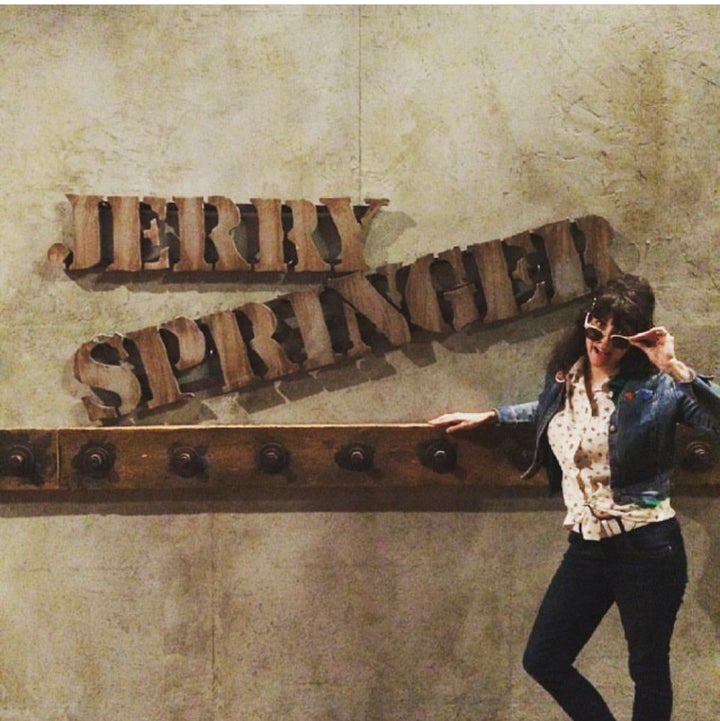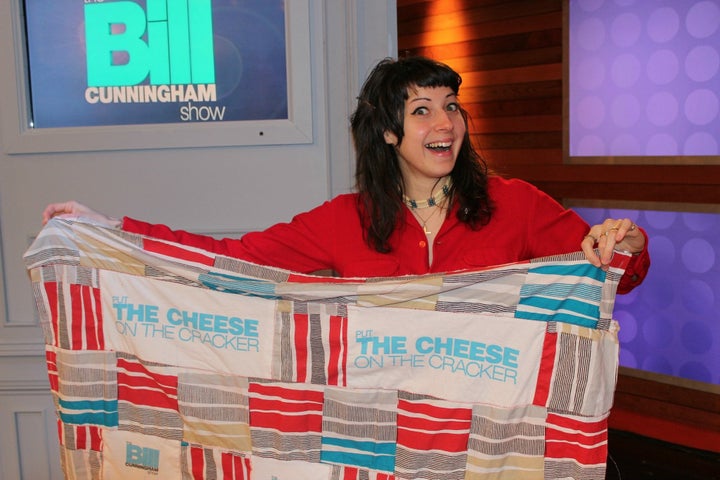
I’m not built for office work. I have always felt at home in a retail environment ― unboxing records, loading pallets, pushing heavy carts of textbooks or lifting something so heavy I need a heating pad at the end of the day.
“I think I can get you an interview,” my ex said.
We were at home in our apartment, and I had just woken up after getting in at 5 a.m. from my job hosting karaoke. It was 1 p.m., but I was comfortable being a nighttime service industry vampire person. I planned to keep hosting karaoke until my presence made people uncomfortable, like a really old Chippendale or an 80-year-old selling door-to-door magazine subscriptions.
My ex was a comedy writer. He would get calls from an agent and offers for job opportunities, which was baffling to me. His legitimacy balanced out the fact that I was in my early 30s trying to find a place to steal photocopies of my zines.
“I dunno,” I said. “That’s not really my ‘thing.’”
“It’s at the Jerry Springer studio in Stamford.”
“How soon can you get me in?”
My earliest memory of a talk show was my mom telling me that she’d read in the TV Guide that the Ninja Turtles were going to be on Oprah. My mom, sister and I gathered around the wood-grained television to watch Oprah suspending her journalistic integrity to talk about pizza and partying with four men in terrifying articulated turtle suits.
Talk shows began to pop up like a small pox rash on the American cultural landscape. As a family, we all tuned in to a 1992 episode of “The Richard Bey Show” where my cousin Lisa was a guest. The episode was simply titled “Boobs” and had women with enormous boobs squaring off against women with small boobs. In typical ’90s talk show fashion, the final guest was a pastor who judged everyone as sinners and whipped the audience into a frenzy.
It’s hard to say what this did to my developing brain, but from that day forward my sister and I watched talk shows from the moment we finished our homework to the moment the evening news came on.
My ex was horrified by my taste in television, born of a youth spent watching makeovers on “Jenny Jones,” club kids on “Ricki Lake,” controlling relationships on “Sally Jesse Raphael,” and endless DNA tests on “Maury.”
“How can you watch this?” he’d say after having walked in on me folding laundry while on the TV, a woman screamed that her child looked just like a man who was taunting her old-school WWF-style.
“It’s soothing. I can’t explain it,” I’d answer, as I folded neat piles of towels and T-shirts to a soundtrack of utter chaos.
The job was out of my league, but my ex talked up my dedication to and knowledge of absolute trash, and the producers agreed to see me. I caught a train to Stamford, Connecticut, and made my way to the studio.
Talk shows used to be filmed in either New York or Chicago, but at some point, rent became astronomical and the last ones standing moved their operations to Connecticut. The final talk show to be taped out of New York was “The Bill Cunningham Show.” He was a Midwestern radio host who for some reason was given a television show despite having no charisma. This coincided with an extended period of unemployment for me wherein I decided to treat being a studio audience member as my job.
The “Bill Cunningham Show” did three tapings a day: The first audience was usually tourists, the second was anyone who stayed for free pizza, and the third was usually people bussed in from halfway houses. We came from all walks of life but had one thing uniting us: We had absolutely nothing better to do with our time.
If you stayed for the third taping of the day, there was a twerk-off, and they would give you a free T-shirt that had Bill Cunningham’s signature phrase on it: Put The Cheese On The Cracker. I thought this was so funny, I became hellbent on amassing as many of these shirts as I possibly could. I eventually made a quilt out of them all, which landed me on their website as Audience Member of the Month.

“Maury,” “Jerry Springer” and its spin-off, “The Steve Wilkos Show,” were taped out of the same studio complex in Stamford. Once I made my way past security, I followed the hallway to the elevator and up to the executive floor where the walls were lined with pictures of Maury, Jerry and Steve in action.
The show I was interviewing for was supposed to be a reality television clip show roundup in the spirit of “Talk Soup.” Once I was in the room with my future bosses, my enthusiasm and knowledge of the deep back catalog of talk show guests did the heavy lifting. I talked about the chicken tetrazzini lady and the girl who had sex for a hamburger, both people who had appeared on Maury between 15 and 20 years ago. I got the job. However, it wasn’t as a writer.
“So the way the show works is we need funny clips of TV,” one producer said. He produced an enormous binder of burned DVDs. “This is the entire back catalog of ‘The Jerry Springer Show.’ We need you to watch it and pull out the funny parts. You can work from home, too.”
To be able to stay home and watch seven hours of Jerry Springer while my ex ― a sucker ― drove to an office in rush-hour traffic was a gift horse I did not want to look in the mouth. There had to be a catch, but I was going to try and enjoy my moment while it lasted.
“Jerry Springer” wasn’t my first choice when it came to daytime television viewing. The overly produced segments just didn’t have the same grit as “Maury,” where lives were ruined in real time. Jerry Springer himself, however, I would have chosen to hang out with over any other talk show host.
He exuded a humour that was absent in most other hosts: a wink-wink boyishness within the circus of his show. He was in on the joke, hovering over the absurdity of it all. As a person, from what I knew, he seemed politically conscious and advocated for people with disabilities. If I had to be stranded on a deserted island with a talk show host, Jerry Springer would have been my top draft.
My first day on the job was easy. I shuffled from the bed to the kitchen to make coffee and feed my only co-worker, a senior pug with leaky anal glands. I popped in the first DVD. I clocked in for six episodes, stopping frequently to pause, record and take notes on any soundbite that seemed slightly funny. I came up with an idea to do a supercut of wigs being ripped off to Mozart’s Serenade No. 13 and chuckled to myself every time I dragged a clip into the new “Eine Kleine Wigmusik” folder on my desktop.

Other than that, it was mostly sad. I tried to press on, clipping parts of fights where the intended target was missed and a few misguided uses of the stripper pole that was on the side of the stage just in case someone was inspired to use it. There were a couple of good audience disses, but overall it was hard to find humour in something so bleak.
It’s not exactly clear when my enthusiasm for the job began to wane. If I had to guess, it would probably be the second or third week of watching nothing but “Jerry Springer.” By this point, my brain had cracked the code for the show’s formula: introduction, secret reveal, confrontation.
They had added something to the formula within the last 10 or 15 years: During the audience commentary at the end, audience members would pull up their shirts and flash for “Jerry Beads.” I thought about the board meeting where that had been agreed upon and wondered which of my bosses had pitched the idea of Jerry Beads.
“Are you OK?” my ex asked me about a month-and-a-half in. I was at that point 360 episodes deep into this show. With three segments produced in each show and three people typically involved in each segment, that meant that I had witnessed roughly 3,000 gladiators in this show’s arena of humiliation.
Each Friday, my paycheque would hit, and I would pass the time between finishing my last episode of the week and waiting for my ex to come home by laying on the floor and staring at the ceiling while I did the arithmetic of how many people had willingly been on this show compared to the population of the United States that particular year. It was like “A Beautiful Mind,” but for confirming my own worst fears that we, as a society, were doomed.
“I’m fine. Why?” I was still in pyjamas at 6 p.m.
“I dunno. Maybe you should take a shower or something. You might feel better.”
When your significant other suggests a shower, it means both A) You need to shower, and B) You are unwell.
Three months in, I had watched 600 episodes. That’s when I decided to go to therapy.
“That’s about 7,000 people. That’s like the population of a small town where everyone is cheating on each other with their mothers, scream-crying, and has an infected Betty Boop tattoo.”
“Well, that’s certainly one perspective,” said Dr. Gene, stifling a laugh.
“What are we going to do in 20 years when these people’s kids have grown up with no impulse control and enter the workforce? They’ll sucker punch you when you ask for a price check on something at Walmart.” I was sweating. The panic was real.
“Maybe you can try to think about what you’ve been able to do with the money from this job instead. You’re in therapy. You were able to pay off your credit card and buy book-binding equipment that you wanted for a long time. Those are positives.”
I thought about it. “I guess.”
“What are you going to do when you leave here?” he asked.
“I’m going to buy a muffin at the farmer’s market and take the train home.”
“Would you have been able to afford that muffin or the train fare three months ago?”
Dr. Gene did have a point with that one.
“See?” he said. “Think about that instead.”
The show we were working on lasted a little under a year. In that time, I watched 1,200 episodes of “The Jerry Springer Show.” It’s hard to say what lasting damage this did to my brain, which is now used to parsing out the true everyday horrors that fill my newsfeed. There is a pending sense of social collapse I have to fight off every day, like mosquitos in the summertime. “The Jerry Springer Show” was a mirror held up to our culture, reflecting back a foul-mouthed, fishnetted, cheating, deadbeat loser.
This feeling of doom was probably there long before I did this to myself. There’s every topless screaming match I saw as a child while watching television before censorship, a rating system, and prolonged bleeps. There’s every day-to-day observation I have now ― a bookstore becoming a vape shop, a child ignored in a stroller while the algorithm babysitting them switches from “Sesame Street” to bikini fails while no one is paying attention, a cousin you didn’t know you disliked until you read their aggressive opinions shouted in all caps over an eagle background.
Then there’s this: The 1,200 episodes I watched of the worst show of all time that somehow became one of the most enduring shows of all time. I can take these things to heart, letting it bog me down like a dedicated audience member drowning in Jerry Beads, or I can hover above it, watching, observing, looking right into the camera and winking when life is at its most absurd.
I know what Jerry would have done.